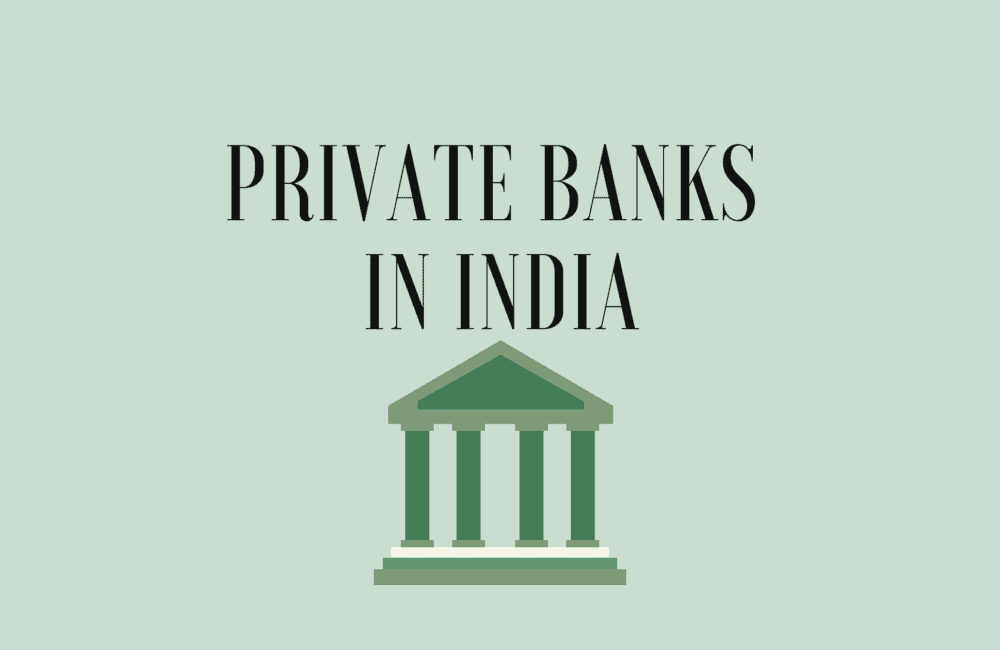The banks are governed and controlled by the central bank in most countries. In India, the Reserve Bank of India is the central bank and it overlooks the functioning of the entire financial system including banks.
Wondering how a bank works behind the scenes? When you deposit money in a bank, it goes into a larger pool of money consisting of deposits from other account holders as well. This amount is then used to provide loans to people requesting it, either for personal, commercial, home, car, or other reasons. But according to the regulations, the bank must have a reserve of around 3% – 10% of the total deposits, and it must be in a position to give you your money should you withdraw it from your account. And it will always have the money. Let’s go through types of banks, government banks vs private banks, top private banks in India.
What Is Bank?
By definition, a bank is a financial institution that is authorized and recognized by the government to handle money and provide loans. By handling money, it can accept deposits into accounts or undertake investments with the money upon the consent of the account holder. Apart from this, banks also provide currency exchanges, deposit safe for putting in actual assets securely, and other wealth management services.
Types Of Banks In India
The Indian banking sector is one of the most advanced in the world, and also one of the most diverse. It all began at the end of the 18th century, with the Bank of Calcutta. This same bank is now known as the State Bank of India. At the time of writing, there are a total of 34 banks in India out of which 12 are public sector banks (fully government-owned) and the remaining are private banks.
Let’s look into each classification of types of banks in more detail.
1) Public Banks In India
These banks come under the bracket of commercial banks. They are the most popular in the country due to their history and high penetration rates. They account for almost three-quarters of the country’s total banking reserve. At this time, SBI is the largest bank in the country. The bank is ranked among the top 50 banks in the world. These banks are public sector banks because the majority shareholder is either the central bank or the government itself.
2) Private Banks In India
These fall under the bracket of commercial banks. The major shareholders of the private banks of India are private firms. But they have to follow all the rules and regulations laid down by the Reserve Bank of India.
3) Foreign Banks
As the name suggests, these are banks based outside of the country but they operate in India as a private bank. Some of the most popular foreign banks who have their presence in India are HSBC, Standard Chartered, Deutsche Bank, etc. These banks have to follow the rules and regulations of the country they originate from, as well as the Reserve Bank of India.
4) Cooperative Banks
They are organized under the state government’s actions and are meant to provide financial freedom to the more lesser-income sections of the society. By providing concessional loans, the cooperative banks aim to uplift their people and promote social welfare. Cooperative banks come in three tiers – at the state level, district level, and village level.
5) Small Finance Banks
This type of bank assists the small farmers, micro-industries, and other unorganized sectors of society. It provides loans and other financial assistance to empower them. These banks are also governed by the Reserve Bank of India. At the time of writing, there are 10 small finance banks in the country.
6) Regional Rural Banks
These are banks that provide concessions and low-cost loans to the rural sector and agriculture sector. These types of banks were set up in 1975 under the Regional Rural Bank Act. They are essentially a joint venture with the central government, state government, and commercial banks. As per the regulations, one Regional Rural Bank cannot open their branch in more than 3 districts interconnected with one other.
Recommended: Top 15 Best Debit Cards in India
Government Banks In India Vs Private Banks In India – The Difference
Both the divisions of banks are highly popular among the Indian public. However, there are some key differences between the two that might drive your decision to choose one over the other for your next bank account. Here is the difference.
| Sr. No. | Government Banks in India | Private Banks in India |
| 1 | More than half of the share of the bank is owned by the Government. | Majority of the share of the bank is held by private firms or individuals. |
| 2 | Since government banks have been in the banking scene for a long time, their customer base is much larger | The customer base of private banks in India is slowly increasing due to the efficiency of their services, but currently, is still less than that of government banks |
| 3 | The interest rates on the deposits by the public is a little bit higher in public sector banks | Depending on the bank, the interest rates may be a little lower for your deposits. However, there can be exceptions |
| 4 | The banking fee of public sector or government banks are lesser | Private banks in India offer better and quicker service, but that comes with higher fees. |
| 5 | The financial performance of Government banks is not higher compared to private banks in India. This financial performance is measured in terms of non-performing assets | The non-performing assets of private banks in India are lower than public sector banks. Again, there may be exceptions with some banks. The private banks in India tend to post more profits or lesser losses due to this. |
Top Private Banks In India List
They have a steadily rising customer base across India’s cities, primarily. Here are all the private banks in India in 2021 that you need to know.
1) HDFC Bank

It is one of the biggest private banks in India and was one of the first banks approved by the RBI to operate as a private bank. HDFC started its operations in 1994 and it is one of the largest operating banks in India by assets.
The banking network is also one of the biggest, with more than 5000 branches across the country and 15,000 ATMs. The financial services and products range consist of everything imaginable from personal, retail, and corporate banking, demat, trading accounts, wealth management, insurance, etc. HDFC Bank offers a clean and robust banking experience through its net banking and m-banking services.
2) ICICI Bank

Another leading and one of the fastest-growing private banks in India. The total assets as of September 30 are more than INR 14 trillion.
ICICI Bank provides a wide range of banking services and products catered to individuals, small business owners, corporates, and retail. They have their trading and Demat platform through which customers can buy and sell stocks, mutual funds, etc. The bank has more than 5000 branches across the country in almost every state, and more than 15,000 ATMs.
They also have a mobile banking and net banking facility which is one of the most advanced and secured among all private banks in India.
3) Axis Bank

One of the most popular private banks in India, it is the third-largest in the country at the time of writing(June 2021). Axis Bank started its operations in 1984 and its headquarters is in Mumbai. From savings accounts to small and large corporates, Axis Bank has a wide array of financial products and services. The bank has more than 4000 branches, 12,000 ATMs in the country, and more than 10 corporate offices/branches in other countries.
4) Kotak Mahindra Bank

It got its banking license from the RBI in 2003 before which it was the NBFC. It was the first NBFC to have been converted to a bank. The bank has been consistently generating profits, in the excess of 5000 crores in 2019. Through the Kotak 811, it provides high-quality neo banking to its customers from all over the country. One can find everything from personal banking, corporate banking, home loans, personal loans, and investment options in Kotak Mahindra Bank.
Kotak Mahindra has more than 2000 ATMs and more than 1000 branches across the country.
5) IndusInd Bank
The bank was started with the initial motive to serve NRIs. Therefore, even today the bank has a huge presence in all metro cities of the country. It also has overseas offices/branches in London, Dubai, and Abu Dhabi. IndusInd Bank offers almost all typical banking products and services from debit cards to loans. Throughout India, the bank has more than 1500 branches and around 2,400 ATMs. IndusInd Bank is based out of Mumbai.
6) Yes Bank
One of the fastest-growing private banks in India, it drove into heights due to its customer-driven service. Yes Bank has a wide range of products and services for individual customers and corporates alike. Yes Bank has more than 1000 branches across the country and is growing.
7) Federal Bank
It is one of the first private banks in India to leverage the power of technology in its banking operations. The bank is headquartered in Aluva, Kerala and it started its operations in 1931.
Since then, the bank has steadily increased its reach across the country. It has more than 1200 branches and more than 1500 ATMs in the majority of the states in the country. The bank has a representative office in Dubai and Abu Dhabi catering to the large Malayali population residing there.
8) IDFC First Bank
While it started as IDFC Bank, it became IDFC First after the merger with Erstwhile Capital First in 2018. With its headquarters in Mumbai, it serves over 70 lakh customers in the country out of which a little below half consist of rural customers. The pan-Indian presence is little though with only around 250 branches and 140 ATMs.
9) South Indian Bank
One of the first banks to implement the Core Banking System, South Indian Bank is based out of Kerala. It has around 800 branches primarily in South India, and around 1,300 ATMs across the country. It provides almost all conventional banking products and services.
10) Bandhan Bank
One of the more recent private banks in India, it started its operations in 2015. Bandhan Bank has its headquarters in Kolkata, West Bengal. Bandhan Bank has customized financial products and services for the urban, semi-urban, and rural populations. It is one of the rare banks to have bound all three types of customers successfully. The objective of the bank is to focus on the people who do not get the benefits of the formal banking system for whatsoever reasons.
11) City Union Bank
Initially started as Kumbakonam Bank, it is headquartered in Kumbakonam, Tamil Nadu. The bank started its operations in 1904 and it was in 1980 that the bank opened its first branch outside Tamil Nadu. The bank’s customer base is steadily increasing too, with more than 700 branches across the country and 1700+ ATMs.
12) CSB Bank
Formerly known as Catholic Syrian Bank, it is one of the oldest private banks in India primarily focused on the public in Kerala. The headquarters of the bank is in Thrissur, Kerala. The bank has a major presence in South India and Maharashtra. At the time of writing, it has around 400 branches, and 300 ATMs across 18 states and 2 UTs. The principal operations of the CSB Bank are in retail banking, SME banking, corporate banking, and treasury.
13) Dhanlaxmi Bank
Another one of the oldest private banks in India, Dhanlaxmi Bank was founded in 1927. The bank has been in the good book of customers ever since, and its headquarters is in Thrissur, Kerala. RBI has recognized the bank as a scheduled commercial bank. The bank is highly popular for its Dhan Bank App, launched in 2015 that provides its customers with banking services on the go. For customer service, there are more than 500 touchpoints of Dhanlaxmi Bank across the country.
14) DCB Bank
One of the new-generation private banks in India, it is a scheduled commercial bank, founded in 1930 in Mumbai, Maharashtra. The business services and products of DCB Bank range from retail, SME, micro-SME, public sectors, agriculture, NBFC, etc. There are more than 6 lakh customers and growing, of the DCB Bank.
DCB Bank has more than 300 high-functional branches across the country in almost all states of South, North, East, and West India.
15) IDBI Bank
IDBI is the shorthand for the Industrial Development Bank of India and is one of the highly preferred private banks in India. But it serves all types of customers with personal banking, loans, investment, and others. The bank is based out of Mumbai but has a significant presence across the country with nearly 2,000 branches and approx. 3000 ATMs.
16) J&K Bank
It is one of the main banks in the UT of Jammu and Kashmir, but it has its presence in the rest of the country as well. With its headquarters in Srinagar, the bank started its operations way back in 1938.
One of the missions of the bank is to increase lending in J&K and also capture specific lending opportunities in the rest of the country. The presence is quite large though, with more than 1000 branches and 1300 ATMs across the country. The customer base of the bank is mostly households and SMEs.
17) Karnataka Bank
One of the top private banks in India, Karnataka Bank has a significant presence even outside the state. The headquarters of Karnataka Bank is in Mangaluru, Karnataka and the bank was established in 1924.
The customer base of Karnataka Bank exceeds 10 million and the bank has more than 800 branches all over the country in almost all the states. The bank has managed to harness the power of technology to deliver high-quality and powerful banking to its customers. Therefore, it has managed to attract customers from outside Karnataka as well.
18) Karur Vysya Bank
One of the leading private banks in India, it has completed 100 years of operations. The bank is headquartered out of Karur in Tamil Nadu. The main segments of the bank are retail banking, corporate banking, wholesale banking, and treasury. One of the major target audiences of the bank is MSME and NRIs. It has around 800 branches across India and more than 1,700 ATMs.
19) RBL Bank
RBL Bank is the modern version of Ratnakar Bank which was established in 1943. It has a legacy of providing high-quality banking services to SME and business merchants in Maharashtra, specifically in the Kolhapur belt. From personal banking to loans, you can find all conventional banking products and services to its customers. Overall, it has around 300 branches and ATMs across the country.
20) Nainital Bank
A subsidiary of Bank of Baroda, it started its operations in 1922 to serve the people of the Nainital region. The majority of its branches operate in the surrounding states and there are around 150 in number.
21) Tamilnad Mercantile Bank
It initially started with Nadar Bank, the bank is based out of Thoothukudi, Tamil Nadu. The bank implements modern technology and banking in almost all its facilities. It has more than 11,000 ATMs across the country and around 500 branches. The majority of the branches are located in urban (non-metro), semi-rural and rural areas.
Also Read: Best Credit Cards in India
Top 10 Private Banks In India – A Comparison
| Sr.No | Bank Name | Number of ATMs | Number of Branches | Facts / Motive | Establishment | Headquarter |
| 1 | HDFC Bank | 13160 | 5103 | Among the first to receive RBI approval to set up a private sector bank | 1994 | Mumbai |
| 2 | ICICI Bank | 14987 | 4874 | Initiative of World Bank, formed to develop a financial institution for businesses in India | 1994 | Mumbai |
| 3 | Axis Bank | 11801 | 4094 | One of the first private banks to begin operations after Indian Government’s acceptance of private banks | 1993 | Mumbai |
| 4 | Kotak Mahindra Bank | 2352 | 1500 | Started to address financial needs of NRI | 2003 | Mumbai |
| 5 | IndusInd Bank | 2605 | 1938 | One of the new generation private sector banks | 1994 | Pune |
| 6 | Yes Bank | 1450 | 1120 | Started to operate as a ‘full service commercial bank’ | 2004 | Mumbai |
| 7 | Federal Bank | 1606 | 1251 | History dates back to before independence, started as Travancore Federal Bank Limited | 1931 | Aluva |
| 8 | IDFC First Bank | 199 | 279 | Set up to finance and support infrastructure in the private sector | 2015 | Mumbai |
| 9 | South Indian Bank | 1400 | 870 | One of the first banks in Kerala to become a scheduled bank | 1929 | Thrissur |
| 10 | Bandhan Bank | 481 | 999 | Started to provide financial inclusion and enable women empowerment. Initially started in rural Bengal | 2001 | Kolkata |
Also Read: How to Use An ATM Machine
Final Thoughts
This is all you need to know about all private banks in India 2021. If you are looking to open an account, check with a bank that has a good customer base, is accessible to you and the fees and service charges match your requirements.
Frequently Asked Questions
Which Is Better For Me – Private Or Government Bank?
It depends on your need and the accessibility of banks at the place you stay in. Both the sectors of banks have their advantages and disadvantages.
How To Open An Account In One Of The Private Banks In India?
Most banks have an option to open a personal bank account online. Just upload the required documents and get your bank account. Alternatively, you can visit the bank branch too.
What Is The Difference Between Savings And Current Accounts?
A savings account is for individuals and the current account is for a company.
Are Net Banking And M-banking Compulsory?
Most banks provide them as complimentary. But it is useful to have them because you can do almost every banking activity online without the need to visit the branch.



